Our nervous system operates through electrical stimuli. Impulses, which have voltage intensities ranging from 5 to 50 mV, travel through our nerves taking information from our sensory organs, or generated in our body, to the brain. The brain responds with new impulses that aim to effect some type of action, contracting muscles, for example.
If something goes wrong with our organism, the stimuli alarm and this is interpreted by the brain as pain. It is right, therefore, that any electrical stimulus, which comes from outside, has a strong action on our nervous system, causing us sensations of all kinds. We get a taste of this when we get shocks.
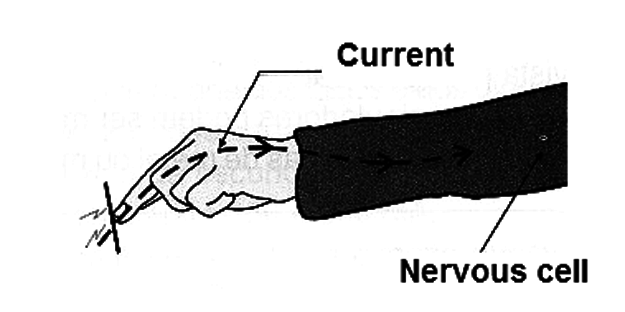
In fact, what we call electric shock is the unpleasant manifestation of electricity in our body, when the intensity of the current or nerve stimuli becomes excessive, and even dangerous, being interpreted this way by our brain. However, what has been discovered is that shock, in its disagreeable form, is not the only action that the electricity applied to the human body can have.
The electric currents, which are forced to circulate through the human body, do not only have the property of stimulating the nerves, causing strange, unpleasant or even pleasant sensations, but they can also cause other types of effects. Researchers have discovered several effects that may help with many types of therapies.
In another paper we have shown how stimuli, frequencies, and controlled intensities were used to permeate the membranes of cancer cells so as to facilitate the penetration of drugs that otherwise had their action blocked. An electronic device was used simultaneously with drug application, increasing its effect by thousands of times.
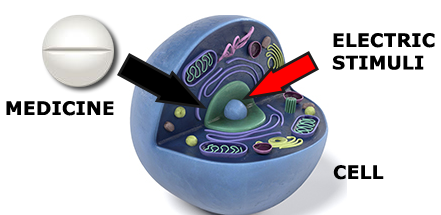
However, controlled electrical pulses can also have important effects on the nervous system, such as controlling pain. The technique of controlling pain with these features is called TENS, or Transcutaneous Electrical Nerve Stimulation.
The TENS equipment is nothing more than controlled pulsed electric generators for the application on the skin and that, penetrating the body and acting on the nervous system, can be used in various therapies, especially for the elimination of chronic pain, in addition to the relaxation and even induction to sleep.
ELECTRICITY AND PAIN
Our body is driven by a true communication network, which receives and sends electrical impulses, informing a central about everything that happens in it. This network is the nervous system and the brain is the central switching and processing. But the most important thing for readers of a magazine of technical electronics is knowing that nerves operate with electrical impulses.
When something goes wrong, in some part of our body is given an alarm signal, and this signal consists of stimuli of a certain type that, going through the nervous system, reaches the brain. These impulses are processed and interpreted as pain. If pain is produced this way, and transmission is made to the brain by electrical impulses, it is clear that external stimulation with appropriate impulses, and of the same nature, can interfere in this system and therefore in the sensation obtained, to the point until its elimination.
Research has shown that pulses of low frequencies, between 40 and 350 per minute, applied at the pain site, produce a relaxing effect that ends by breaking the vicious cycle of tension - spasm. Electrical stimulation equipment, have been widely used in dental practices for many years, with positive results.
However, advances in the studies have shown that if the low frequency of the stimuli is modulated with a higher frequency of the order of 100 Hz, faster myo-relaxant and analgesic effects occur, and the unpleasant sensation caused by isolated pulses is eliminated .
The device, which is connected to the patient through adherent electrodes with a special gel, which facilitates the transfer of the electrical stimuli, causes a muscular relaxation, which brings great benefits.
It is important to note that many chronic headaches and even earaches are radiated pains. A tensioning of the masticatory musculature made irregularly by an occlusion deficiency, for example, can cause the patient to feel constant headaches and earaches, which are neither localized by conventional examinations nor cut out by traditional therapy.
The dental treatment, accompanied by the stimulation of the muscle that, through the vicious cycle of tension - spasm - causes pain, leading to relaxation, can have surprising effects. The action of the stimuli, in the case of tense muscles, which can cause deep pains, has a simple explanation to be understood: The muscles are formed by cells in the form of spindles which contract in the direction of their length when they are stimulated, as shown in Figure 3.
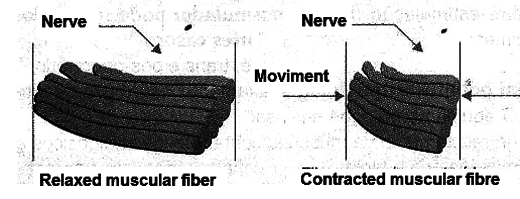
Thus, with each nerve stimulus, with contraction the total length of the muscle fiber is reduced, and with this the muscle can exert a mechanical force, for example, by moving a jaw. However, what we have is the realization of mechanical force for a finite time, which, physically, implies work and therefore the conversion of energy.
This energy comes from the burning of fats, which means that toxins, i.e., substances resulting from metabolism are produced in the process and must be eliminated. When we do a heavy exercise, the production of toxins may be greater than the rate at which they are eliminated, and when this occurs, their accumulation in muscle tissue causes the pain.
A state of marked "stress" or even nervous tension can prevent a muscle from relaxing after a process of use and with that, the toxins produced will be eliminated with difficulty. The result of this is also pain. Likewise, a problem of dental occlusion can keep the muscles of a jaw tense, to the point of making it difficult to eliminate toxins and causing pain.
Many people, under these conditions, may feel strong chronic pains that are radiated appearing as headaches or earaches. These pains are due both to the presence of non-eliminated toxins in the muscle fibers due to the difficulty of their relaxation and to their own tension that stimulates the nerves intensely.
The application of rhythmic stimuli, such as those proposed by many researchers, causes a contraction and rhythmic distension which forces the elimination of toxins through exercise, and with this reestablishes the normal condition of the fibers: relaxed and without toxins. Obviously, besides the pleasant sensation obtained, which can even lead the patient to sleep, there is relaxation and elimination of pain.
In short, controlled electrical stimuli applied this way can relax tense muscles and thereby lead the patient to pain relief, elimination of harmful toxins, relaxation, etc.
THE INDICATIONS
The possibility of a portable electro-stimulator, which can be used anywhere, which has no contraindications or requires a prescription, is undoubtedly attractive to many readers who suffer from chronic pain problems. However, it should be remembered that the pain is caused by several unfavorable situations in which the body is found.
This means that any mechanism that can eliminate pain is important as long as the causes are not forgotten. Thus, equipment of this type should be used with caution and wisely, since the cause of the pain, which is to be eliminated, must be identified by a professional. Among the possible applications for electrostimulation, we highlight the following:
A) In odontostomatology
The equipment can be used in the relaxation of masticatory and facial muscles.
We can use it in the diagnosis and treatment of TMJ (Temporomandibular Joint) dysfunctions, neuropathies and myalgias of the masticatory musculature.
Treatment of inflammatory and painful processes, acute and chronic.
Prophylaxis and prevention of postoperative pain and edema.
Patient relaxation in the pre and trans-operative period, potentiating the anesthetic and analgesic effect, increasing the threshold of perception and reaction to pain.
Treatment of trismus, spasms and contractures of superficial and deep musculature of the face.
Acceleration of scarring processes.
B) In oral rehabilitation and prosthesis applications, it can be used to:
Relaxing and deprogramming the masticatory and facial muscles.
Shaping the muscular cutout in total and partial prosthesis (myo-dynamic impression).
Detecting occlusal trauma
Adjusting premature contacts (coronoplasty)
Determining the interocclusal free space
Getting maxillo-mandibular records
Repositioning the mandible in its physiological neuro-muscular trajectory
Normalizing the balance of the neutral-muscular system
Obtaining the myocentric trajectory of the mandible
Obtaining the Myocentric Occlusion through the deprogramming of proprioceptive memory.
C) In surgery and general medicine, the electro-stimulator can be used in the following cases:
In pre, trans and postoperative
Neuro-psycho-muscular relaxation
Obtaining analgesic and anti-inflammatory effects in postoperative.
For general analgesia
In eliminating stress and anxiety
D) In Orthopedics, Physical Therapy and Sports Medicine:
Fulfills all TENS applications
E) In Psychotherapy and Psychology:
Induction to physical and mental relaxation easier and faster
F) Other areas of application:
Facial aesthetics
Speech Therapy
Neuro-muscular rehabilitation
Induction to artificial or physiological sleep
Elimination of tension and fatigue
Treatment of tension headaches
Reactivation of neuro-muscular functions
PORTABLE VERSIONS
An important feature of TENS is that for its portable versions there are no contraindications (*) and therefore it can be used without a prescription.
(*) In fact, the only contraindication is in the case of patients using unshielded pacemakers and who may have this device affected by the pulses generated by the stimulator. Of course, as we warned in the article, that pain is a kind of alarm that our body throws when something goes wrong, cutting the pain without checking its cause, is like turning off a fire alarm in a building catching fire waiting, with that , for the fire put out itself.
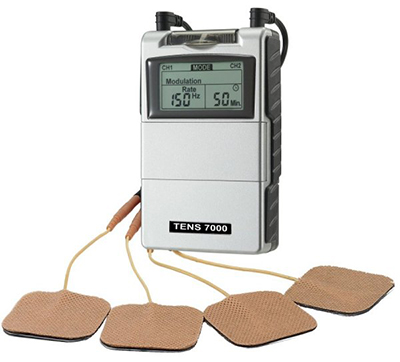
If the cause of the pain is known and proper treatment is done (consult a professional - dentist, doctor, etc.), the use of the device can mean both an aid in this treatment and a relief to the discomfort it causes. These handsets are usually powered by a standard 9 V battery or small batteries, with good autonomy.
The electrical impulses are applied to the patient by adhesive electrodes, impregnated with a special gel which facilitates electrical conduction. The apparatus is supplied with a certain amount of electrodes, but these electrodes can be purchased separately in any quantity according to the needs of the treatment.
The typical electronic circuit is formed by two oscillators that have frequency adjustments made through common potentiometers. The intensity range of the generated pulses is determined by the searches, in order to obtain the desired effects, as well as their frequency.
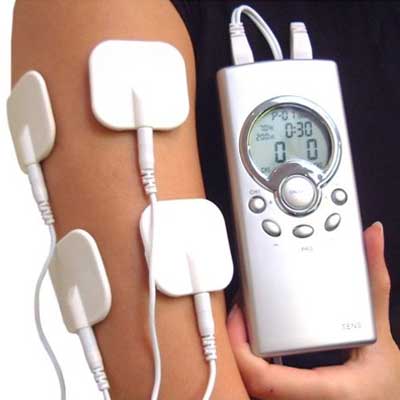
In determining the intensity and frequency of the pulses, both the site of the application, the target therapy and the effect are taken into account, as well as the fact that the conductivity of the skin through which the stimuli have to pass is not the same for each person. Thus, because each situation requires a user-made adjustment, access to the controls is important to achieve the desired effects.
The use has no limits as to the time, there are cases of people who use it as relaxing in order to inducing sleep, and sleep with the connected apparatus.
The Maintenance of Medical Device
Many of our readers would like to understand more of many medical devices, such as TENS, to be able to provide repair services to their local offices. It is clear, in this case, that the repair of a TENS Stimulator is relatively simple, since they are circuits formed by low frequency oscillators, timers and sources whose signals can be observed on any oscilloscope and the voltages measured with simple multimeters. In most cases, the components themselves are in common use, offering no difficulty to repairers.
Revised 2017



